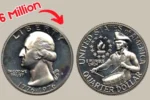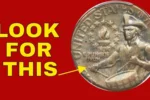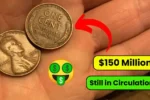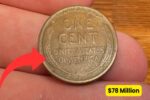Rare Lincoln Wheat Pennies Worth Over $677,777 – Key Coins & Features to Identify
Over the years, Lincoln Wheat Pennies have become one of the most coveted treasures for coin collectors. With some ultra-rare versions fetching jaw-dropping prices at auctions, these tiny copper coins—minted between 1909 and 1958—aren’t just pocket change. They carry immense historical relevance in addition to their monetary value.
If you happen to stumble upon a rare Wheat Penny, you could be looking at a payday in the hundreds of thousands. In fact, a few select examples have sold for more than $677,777. Wondering what makes these coins so special and how you can tell if you have one? This guide will walk you through everything—what to look for, where they come from, and why collectors are willing to pay big money for them.
Rare Lincoln Wheat Pennies Worth Over $677,777
| Feature | Details |
|---|---|
| Most Valuable Coin | The 1943-D Bronze Cent, which sold for $840,000. |
| Rare Types | 1943 Bronze Cents, 1944 Steel Cents, 1909-S VDB, 1992 Close AM, 1999 Wide AM |
| How to Spot Them | Check for odd metals, mint marks, date mistakes, and design quirks |
| Authentication Services | NGC (Numismatic Guaranty Corporation) and PCGS (Professional Coin Grading Service) |
| Official Info | U.S. Mint offers full specs and historical details |
Lincoln Wheat Pennies aren’t just old coins; they’re pieces of American history. Some, like the 1943 Bronze Cent, came into being because of wartime metal shortages. Others, such as the controversial 1909-S VDB, tell stories of artistic pride and public backlash. If you learn how to properly identify these rare coins, you might find yourself holding a true historical artifact that could be worth a small fortune.
These coins prove that even the most ordinary-seeming items—like loose change—can hold extraordinary value, both economically and historically. Whether you’re deep into the hobby or just getting started, discovering a rare Lincoln Wheat Penny is a thrill in itself. The coin collecting community is full of knowledge and resources that make the experience even more rewarding.
Why Are Some Lincoln Wheat Pennies So Expensive?
The value of a Lincoln Wheat Penny often comes down to a few key factors: rarity, condition, and minting errors. Coins that were misprinted or produced in small quantities can go for incredible amounts. Here’s what contributes to their high value:
- Mint Errors: Mistakes like striking on the wrong metal or misaligned designs create rare coins that collectors love.
- Low Production Numbers: Coins like the 1909-S VDB had limited mintage, making them scarce today.
- Historical Ties: These coins reflect pivotal moments in U.S. history, such as WWII material shortages.
From wartime compromises to design controversies, these factors have locked certain Wheat Pennies into numismatic legend. Collectors chase these stories as much as they chase the coins themselves.
The Artistic Side of the Penny
The Lincoln Wheat Penny design features Abraham Lincoln on one side and two wheat stalks on the reverse—a nod to both hardship and prosperity. This symbolism gives the coin a timeless quality. Beyond collectibility, these designs serve as markers of national identity and pride, making them culturally valuable too.
Noteworthy Lincoln Wheat Pennies You Should Know About
1. 1943 Bronze Cents
In 1943, due to copper shortages during WWII, the U.S. Mint started producing pennies from steel coated with zinc. However, a few leftover bronze blanks from 1942 accidentally got used, leading to the now-legendary 1943 Bronze Cent.
- 1943-D Bronze Cent: The only known one from Denver fetched $840,000 at auction.
- 1943-S Bronze Cent: One from the San Francisco mint sold for $504,000.
How to Confirm One:
- Weight: Real bronze cents weigh around 3.11 grams; steel ones are lighter at 2.7 grams.
- Magnet Test: Steel is magnetic; bronze is not.
Due to widespread fakes, grading services like NGC or PCGS are crucial to verify authenticity. A certified coin can sell for significantly more.
2. 1944 Steel Cents
When copper was brought back for pennies in 1944, a few steel planchets remained in the machines, creating the rare 1944 Steel Cent. One of these sold for $373,750.
Spotting Tips:
- Commonly found from Denver (D) or San Francisco (S) mints.
- Color: Steel cents have a distinctive silver-gray tone.
These rare coins offer insight into how the U.S. Mint adapted to changing materials during wartime.
3. 1909-S VDB Penny
Perhaps the most famous Lincoln Wheat Penny, the 1909-S VDB was designed by Victor David Brenner. His initials, boldly placed on the reverse, sparked backlash and were quickly removed after only 484,000 coins were minted.
Why It’s Special:
- Extremely limited run
- Historic design controversy
Fun Fact: This controversy adds to the coin’s fame. Collectors now see it as a tribute to artistic freedom and historical pushback.
4. 1992 Close AM Penny
The 1992 Close AM Penny features a rare design flaw where the letters “A” and “M” in “AMERICA” are printed unusually close together. Some of these can bring in $26,000.
How to Spot It:
- Use a magnifying glass and check the spacing between the letters on the back.
Modern errors like these prove that even relatively recent coins can be worth thousands if they have distinctive features.
5. 1999 Wide AM Penny
This coin error is the opposite of the 1992 Close AM. The 1999 Wide AM Penny has extra space between the “A” and “M,” using a proof reverse by mistake. Depending on condition, these sell for $173 to $2,300.
Check for These Clues:
- A visible gap between the “A” and “M”
- Shinier finish, typical of proof coins
These mix-ups between proof and circulation designs keep collectors fascinated by even the smallest details.
How to Spot a Rare Lincoln Wheat Penny Worth Over $677,777
Check the Date & Mint Mark
- Important years: 1909, 1943, 1944
- Look under the date:
- “D” = Denver
- “S” = San Francisco
- No mark = Philadelphia
Inspect for Errors
- Look closely for design irregularities like double lettering or off-center prints.
- Errors such as “doubled dies” can drastically increase a coin’s value.
Use a Scale
- Accurate weight can help identify misstruck or rare metal coins. Even small differences matter.
Get a Professional Opinion
- Submitting to PCGS or NGC confirms authenticity and condition—both critical for determining resale value.
Do Some Market Research
- Auction sites like Heritage Auctions or Stack’s Bowers help you track what similar coins are currently selling for.
FAQs
Q: What makes the 1943 Copper Penny so rare?
A: It was mistakenly made from copper during a time when pennies were being struck in steel due to war shortages.
Q: Which Lincoln Wheat Penny is worth the most?
A: The 1909-S VDB and 1943 Bronze Cent are among the top, each valued over $677,777.
Q: How should I store valuable coins?
A: Use protective cases, keep them in a dry environment, and avoid touching the surface with bare hands to preserve their condition.











